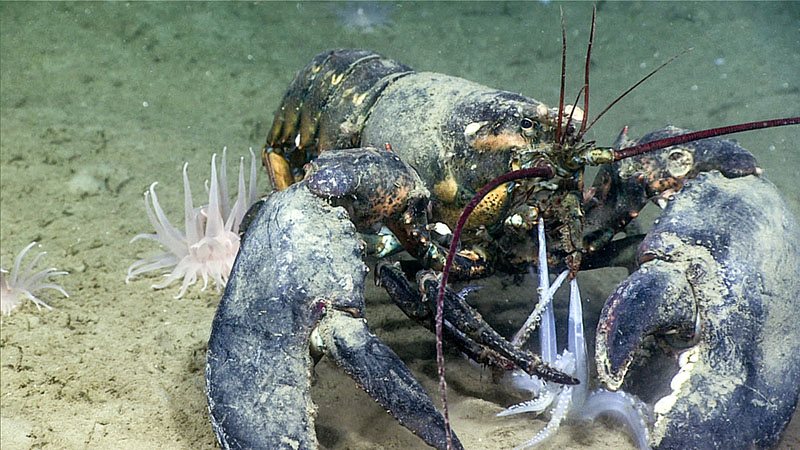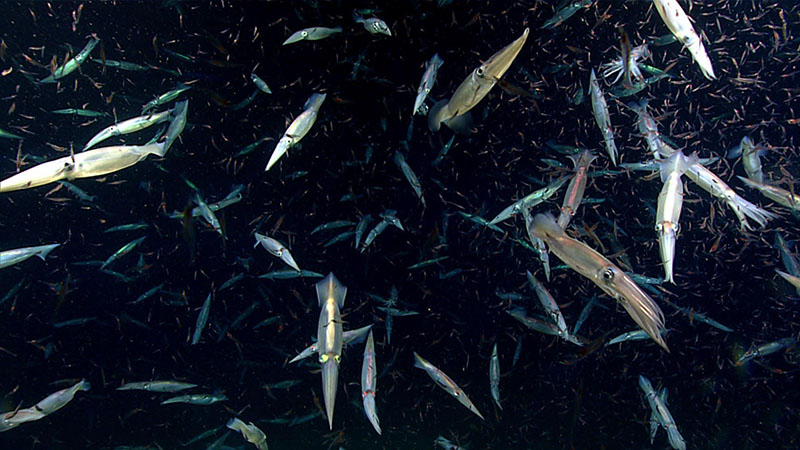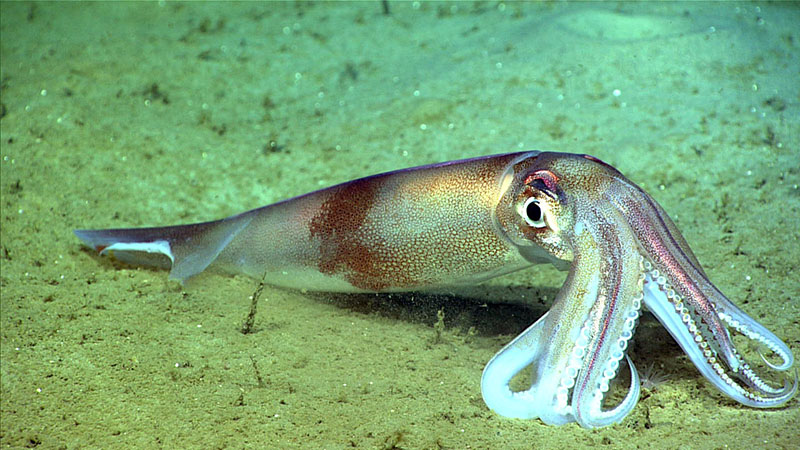
by Mike Vecchione, NOAA/NMFS National Systematics Laboratory
September 12, 2019

An American lobster (Homarus americanus) eating a squid during dive 3 of the Deep Connections 2019 expedition. Image courtesy of the NOAA Office of Ocean Exploration and Research. Download larger version (jpg, 1.5 MB).
While exploring a shallow (306 - 358 meter) soft-bottom area off Canada on August 31, 2019, remotely operated vehicle Deep Discoverer (D2) came across a large lobster eating its dinner. What did the lobster have for dinner? Calamari. But how could a lobster catch a squid? This lobster and many other bottom-living animals dined that day on pieces of shortfin squid falling from the water column. A curious part of the scene was that it was generally pieces, not just whole squid, falling like manna from above.

Northern shortfin squid (Illex illecebrosus) actively feeding on a large swarm of crustaceans during dive 3 of the Deep Connections 2019 expedition. Image courtesy of the NOAA Office of Ocean Exploration and Research. Download larger version (jpg, 909 KB).
Earlier in the dive, D2 had documented very large numbers of Northern shortfin squid (Illex illecebrosus) actively feeding on a large swarm of crustaceans, probably northern krill (Meganyctiphanes norvegica). Illex illecebrosus is a commercially and ecologically important squid species in the muscular and very active family Ommastrephidae. When shortfin and other ommastrephid squids get excited about feeding, they will grab and bite just about anything around them. Of course, the most abundant animals in the water other than krill, were the squid themselves. D2 documented squid-on-squid violence and several squid with obvious damage. Cannibalism has been reported many times for ommastrephid squids, including I. illecebrosus.

One squid attacking another during dive 3 of the Deep Connections 2019 expedition. Image courtesy of the NOAA Office of Ocean Exploration and Research. Download (jpg, 97 KB).

A Northern shortfin squid with a large bite out of one of its fins, sitting on the seafloor. Several squid with such bite marks were observed during dive 3 of the Deep Connections 2019 expedition. Image courtesy of the NOAA Office of Ocean Exploration and Research. Download larger version (jpg, 1.1 MB).
Shortfin squid are sloppy feeders. They use their beaks to bite their prey into pieces and often drop some pieces while eating the best parts. Regular followers of NOAA Ship Okeanos Explorer expeditions may remember a dive last year when Illex squid were seen feeding on midwater fishes and dropping numerous fish heads onto the bottom. They may also remember a dive in 2017, when many bottom animals were feeding on whole squid of a closely related species. Whereas the latter probably resulted from post-spawning death of the squid, the more recent observations from the Deep Connections 2019 expedition on August 31st were likely a result of cannibalism during overly enthusiastic feeding.
Check out a highlight video featuring many of these interactions here:
A “squid storm” of shortfin squid (Illex illecebrosus) swarmed around the Deep Discoverer throughout Dive 4 of the Deep Connections 2019 expedition. The squid were seen feeding on shrimp, fish, and possibly each other—but they were not the only ones enjoying a snack! Video courtesy of the NOAA Office of Ocean Exploration and Research, Deep Connections 2019. Download larger version (mp4, 96.4 MB).
More information: